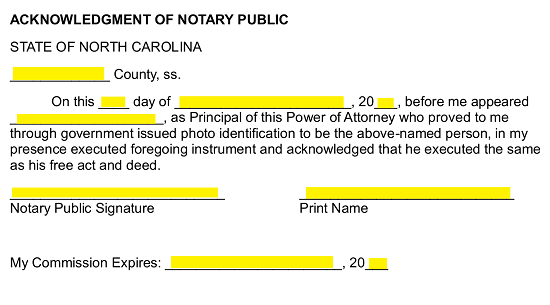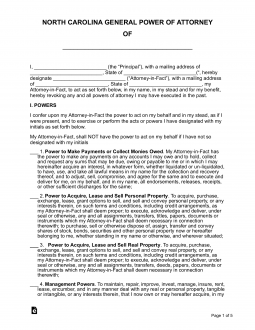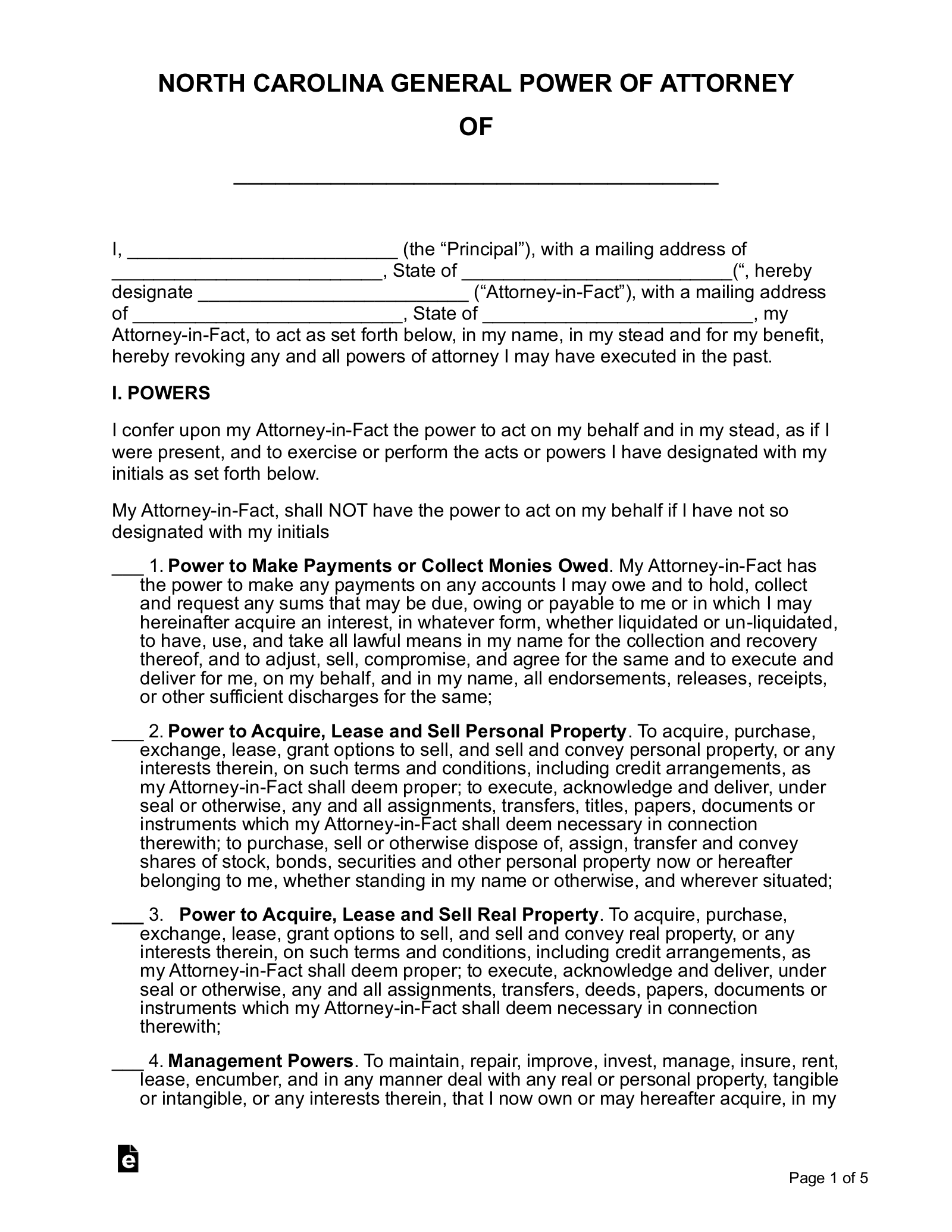Updated August 09, 2023
A North Carolina general (financial) power of attorney is a document that allows you to designate someone to represent your general financial interests. This form is a general form, meaning that unless you state otherwise, it will automatically terminate upon your incapacity, unlike the durable form which continues in effect. There are ways you can draft this form to become durable, or you can use this form instead if you want it to continue beyond your incapacity.
Laws
- Statutes – North Carolina Uniform Power of Attorney Act (§§ 32C-1-101 — 32C-4-403)
- Authority (N.C.G.S.A. § 32C-2-201) – An agent under a power of attorney may act on behalf of the principal and exercise broad authority as granted by the agreement.
- Signing Requirements (N.C.G.S.A. § 32C-1-105) – Notary Public.
How to Write
Download: PDF, MS Word, OpenDocument
1 – The Title And Introduction Will Need To Be Prepared With Some Information
Before we fill out the introduction then present this paperwork to the Principal for review, we will need to tend to the Title of this document. Fill in the Name of the Principal on the blank line in this title. This is the entity that intends to approve an Attorney-in-Fact’s use of his or her Authority in the matters defined below.  Now let us focus on the paragraph making up this paperwork’s introduction. The first three blank spaces seek a definition to the Principal listed in the title. List his or her First, Middle, and Last Name onto the first blank space of this statement.
Now let us focus on the paragraph making up this paperwork’s introduction. The first three blank spaces seek a definition to the Principal listed in the title. List his or her First, Middle, and Last Name onto the first blank space of this statement.  Make sure you also use the next two spaces to produce the Street Address and State of the Principal’s Mailing Address.
Make sure you also use the next two spaces to produce the Street Address and State of the Principal’s Mailing Address.  The three blank spaces that follow the word “…Designate” call for a declaration of the Attorney-in-Fact’s identity. Fill in the Attorney-in-Fact’s legal full Name on the first empty space.
The three blank spaces that follow the word “…Designate” call for a declaration of the Attorney-in-Fact’s identity. Fill in the Attorney-in-Fact’s legal full Name on the first empty space.  Next, furnish the Attorney-in-Fact’s Mailing Street Address and State onto the next two available spaces.
Next, furnish the Attorney-in-Fact’s Mailing Street Address and State onto the next two available spaces. 
2 – A Proven Principal Approval Must Be Supplied For Each Delegation Of Power
Once we have produced the Principal and Attorney-in-Fact identities, it will be time to report which affairs the Principal wishes to grant the Attorney-in-Fact Authority in. This can be a daunting task due to the scope of possibilities and the need to use a specific language. Luckily, Article “I. Powers.” Here, the Principal can simply review the subject matters listed. If the Principal decides that a paragraph adequately describes the type of actions and/or decisions the Attorney-in-Fact should be able to engage in, the Principal should initial that paragraph. If a certain paragraph contains a description of actions the Principal will not approve the Attorney-in-Fact’s taking, then such a statement should be left unmarked and blank.
The first item on this list will enable the Principal to bestow the “Power To Make Payments Or Collect Monies Owed” in his or her name to the Attorney-in-Fact. This will allow the Attorney-in-Fact to make payments on debts using the Principal’s Authority or forgive debts owed to the Principal. If the Attorney-in-Fact has the Principal approval to act in this manner, then the Principal should initial the blank line that precedes the number “1.”  The second statement in this article is titled “Power To Acquire, Lease And Sell Personal Property.” When the Principal initials this statement he or she will approve the Attorney-in-Fact’s use of Principal Power to engage in activities such as conveying the Personal Property of the Principal (this includes stocks, bonds, securities, etc.).
The second statement in this article is titled “Power To Acquire, Lease And Sell Personal Property.” When the Principal initials this statement he or she will approve the Attorney-in-Fact’s use of Principal Power to engage in activities such as conveying the Personal Property of the Principal (this includes stocks, bonds, securities, etc.).  The Principal can deliver the “Power To Acquire Lease ANd Sell Real Property” in his or her Name to the Attorney-in-Fact by initialing the third blank line in this list. This will give the Attorney-in-Fact the ability to perform actions such as making credit arrangements for the sake of acquiring or selling Real Property on behalf of the Principal.
The Principal can deliver the “Power To Acquire Lease ANd Sell Real Property” in his or her Name to the Attorney-in-Fact by initialing the third blank line in this list. This will give the Attorney-in-Fact the ability to perform actions such as making credit arrangements for the sake of acquiring or selling Real Property on behalf of the Principal.  The “Management Powers” under the Principal’s Authority can be executed by the Attorney-in-Fact to handle the maintenance, leasing, insuring, renting, etc. of Real or Personal Principal Property as per the fourth item on this list if the Principal initials the blank line attached to the number “4.”
The “Management Powers” under the Principal’s Authority can be executed by the Attorney-in-Fact to handle the maintenance, leasing, insuring, renting, etc. of Real or Personal Principal Property as per the fourth item on this list if the Principal initials the blank line attached to the number “4.”  The Principal’s ability to open accounts or close them with financial institutions along with a scope of other actions can be granted to the Attorney-in-Fact if the Principal initials the “Banking Powers” paragraph. To restrict the Attorney-in-Fact from dealing with financial institutions in the way defined by this description, then the Principal should leave this unmarked.
The Principal’s ability to open accounts or close them with financial institutions along with a scope of other actions can be granted to the Attorney-in-Fact if the Principal initials the “Banking Powers” paragraph. To restrict the Attorney-in-Fact from dealing with financial institutions in the way defined by this description, then the Principal should leave this unmarked.  If the Attorney-in-Fact should have the Principal Authority to represent the Principal’s interests with “Motor Vehicles” in the manner described by the sixth paragraph, the blank line corresponding to the number “6” must be initialed by the Principal.
If the Attorney-in-Fact should have the Principal Authority to represent the Principal’s interests with “Motor Vehicles” in the manner described by the sixth paragraph, the blank line corresponding to the number “6” must be initialed by the Principal.  If the Principal expects the Attorney-in-Fact to fully represent him or her when dealing with Tax Entities (i.e. the I.R.S.) then the “Taxes” paragraph statement must be initialed by the Principal.
If the Principal expects the Attorney-in-Fact to fully represent him or her when dealing with Tax Entities (i.e. the I.R.S.) then the “Taxes” paragraph statement must be initialed by the Principal.  The Principal can approve the Attorney-in-Fact’s access and actions with his or her “Safe-Deposit Boxes” as per the eighth item when he or she initials this power description.
The Principal can approve the Attorney-in-Fact’s access and actions with his or her “Safe-Deposit Boxes” as per the eighth item when he or she initials this power description.  The Attorney-in-Fact can possess the same “Gift Making Powers” the Principal may exert so long as the Principal initials the blank space corresponding to the ninth item on this list.
The Attorney-in-Fact can possess the same “Gift Making Powers” the Principal may exert so long as the Principal initials the blank space corresponding to the ninth item on this list.  The tenth paragraph in this list will concentrate on defining the type of “Lending And Borrowing” actions the Attorney-in-Fact may take with the Principal’s Name. If the Principal has determined the Attorney-in-Fact should wield this type of Authority, then he or she should initial the blank line corresponding to the number 10.
The tenth paragraph in this list will concentrate on defining the type of “Lending And Borrowing” actions the Attorney-in-Fact may take with the Principal’s Name. If the Principal has determined the Attorney-in-Fact should wield this type of Authority, then he or she should initial the blank line corresponding to the number 10.  If the Attorney-in-Fact can conduct the Principal’s commitments to “Contracts” if the Principal initials item eleven.
If the Attorney-in-Fact can conduct the Principal’s commitments to “Contracts” if the Principal initials item eleven. ![]() The twelfth item on this list describes the decisions and actions that can be taken with the Principal’s “Health Care.” The Principal will have to initial this item to allow the Attorney-in-Fact’s use of this Authority.
The twelfth item on this list describes the decisions and actions that can be taken with the Principal’s “Health Care.” The Principal will have to initial this item to allow the Attorney-in-Fact’s use of this Authority.  The Attorney-in-Fact can be named as a representative of the Principal as per the Health Insurance Portability And Accountability Act Of 1996 if the Principal initials the blank line corresponding to the number 13. This type of representation may be withheld from the Attorney-in-Fact’s scope of Principal Powers if the Principal leaves this statement blank.
The Attorney-in-Fact can be named as a representative of the Principal as per the Health Insurance Portability And Accountability Act Of 1996 if the Principal initials the blank line corresponding to the number 13. This type of representation may be withheld from the Attorney-in-Fact’s scope of Principal Powers if the Principal leaves this statement blank.  The “Power To Hire And Pay For Services” can be delegated to the Attorney-in-Fact once the Principal reads and initials the fourteenth paragraph of this list.
The “Power To Hire And Pay For Services” can be delegated to the Attorney-in-Fact once the Principal reads and initials the fourteenth paragraph of this list.  If the Attorney-in-Fact’s Reimbursement can be handled by the Attorney-in-Fact wielding Principal Power, then the “Reimbursement Of Attorney-in-Fact” declaration must be initialed by the Principal.
If the Attorney-in-Fact’s Reimbursement can be handled by the Attorney-in-Fact wielding Principal Power, then the “Reimbursement Of Attorney-in-Fact” declaration must be initialed by the Principal. ![]() If the Principal “Power To Sue Third Parties Who Fail To Act Pursuant To Power Of Attorney” should be within the Attorney-in-Fact’s ability to wield Principal Authority, then item 16 must be initialed by the Principal. This can act as an enforcement measure for this document should the Attorney-in-Fact’s right to represent the Principal in the matters defined above be questioned or disregarded.
If the Principal “Power To Sue Third Parties Who Fail To Act Pursuant To Power Of Attorney” should be within the Attorney-in-Fact’s ability to wield Principal Authority, then item 16 must be initialed by the Principal. This can act as an enforcement measure for this document should the Attorney-in-Fact’s right to represent the Principal in the matters defined above be questioned or disregarded.  The Principal can also include direct instructions to the Attorney-in-Fact and those dependent on this document to carry out the Principal’s preferences. It is strongly recommended that when extending the Principal Authority in this item, that any such instructions be reviewed by a qualified professional. Once this item has been filled out and initialed by the Principal it will be considered part of this delegation of Power. Note: If more space is required, you may cite a clearly dated and titled attachment that contains the remainder of the Principal’s preferences.
The Principal can also include direct instructions to the Attorney-in-Fact and those dependent on this document to carry out the Principal’s preferences. It is strongly recommended that when extending the Principal Authority in this item, that any such instructions be reviewed by a qualified professional. Once this item has been filled out and initialed by the Principal it will be considered part of this delegation of Power. Note: If more space is required, you may cite a clearly dated and titled attachment that contains the remainder of the Principal’s preferences. 
3 – The Calendar Dates When This Delegation Becomes Active And Terminates Should Be Defined
The third article in this paperwork, titled “Effective Date ANd Termination,” will seek a Principal definition to the first and last Calendar Dates the Attorney-in-Fact can wield Principal Authority. This definition can only be supplied through the Principal act of initialing one of the first two and one of the last three statements in this section.
One of the first two statements in this section should be initialed by the Principal to prove the Principal’s intent on how and when this document goes into effect. If it should become active on the same Calendar Date the Principal signs it, then the first statement should be initialed.  If, however, this paperwork goes into effect only upon a specific Calendar Date then the second statement must be initialed, and the Calendar Start Date supplied to the blank lines after the words “…Following Date.”
If, however, this paperwork goes into effect only upon a specific Calendar Date then the second statement must be initialed, and the Calendar Start Date supplied to the blank lines after the words “…Following Date.” One of the last three statement will need to be initialed by the Principal to demonstrated when or how the Principal Powers listed in the previous section become inactive or ineffective. The Principal can list a predetermined Calendar Date of Termination for these Powers by initialing the blank line before the words “On The Following Date…” then supplying that Date to the using the two blank spaces that follow.
One of the last three statement will need to be initialed by the Principal to demonstrated when or how the Principal Powers listed in the previous section become inactive or ineffective. The Principal can list a predetermined Calendar Date of Termination for these Powers by initialing the blank line before the words “On The Following Date…” then supplying that Date to the using the two blank spaces that follow. 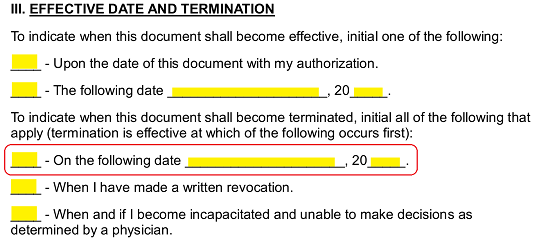 If these Powers remain in Effect until a written revocation has been issued by the Principal, the second statement must be initialed by the Principal.
If these Powers remain in Effect until a written revocation has been issued by the Principal, the second statement must be initialed by the Principal. 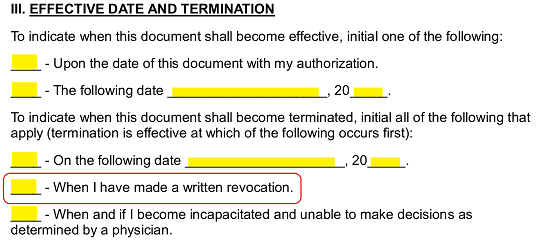 If the Attorney-in-Fact should retain Principal Power until a Physician has issued a written declaration that the Principal is incapacitated, then the third statement here must be initialed by the Principal.
If the Attorney-in-Fact should retain Principal Power until a Physician has issued a written declaration that the Principal is incapacitated, then the third statement here must be initialed by the Principal. 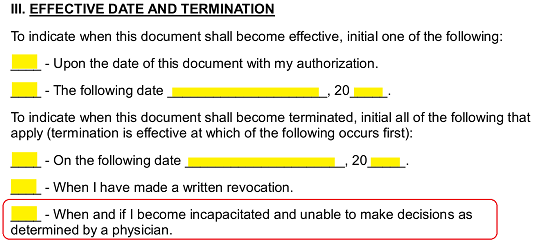
4 – The Principal And Attorney-in-Fact Signatures Are Mandatory Items To Execute This Paperwork
The closing of this paperwork will supply a final declaration statement followed by an area where the Principal may agree with a Dated Signature. The sentence starting with the term “In witness Whereof…” contains two blank spaces the Principal should use to document the Signature Calendar Month, Day, and Year.  This paperwork will only go into Effect when the Principal signs his or her Name to the “Principal’s Signature” line then prints his or her Name on the adjacent blank space (“Print Name”).
This paperwork will only go into Effect when the Principal signs his or her Name to the “Principal’s Signature” line then prints his or her Name on the adjacent blank space (“Print Name”).  Once the Principal has executed his or her signature, this document should be given to the Attorney-in-Fact for a quick review. Upon satisfaction, the Attorney-in-Fact should print his or her Name on the first available space in the “Acceptance Of Appointment” section.
Once the Principal has executed his or her signature, this document should be given to the Attorney-in-Fact for a quick review. Upon satisfaction, the Attorney-in-Fact should print his or her Name on the first available space in the “Acceptance Of Appointment” section.  If the Attorney-in-Fact acknowledges and accepts this appointment, then he or she should sign and print his or her Name utilizing the two blank spaces in this section.
If the Attorney-in-Fact acknowledges and accepts this appointment, then he or she should sign and print his or her Name utilizing the two blank spaces in this section. 
The last entity to take control of this paperwork will be the Notary Public. This party will use his or her credentials to verify the signing and to provide the notarization seal required for this process. 